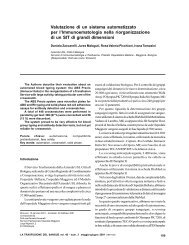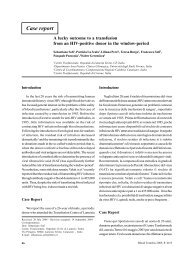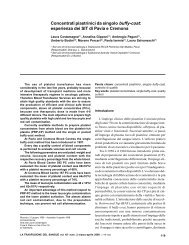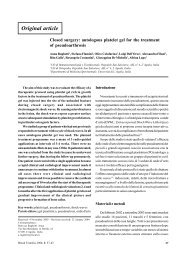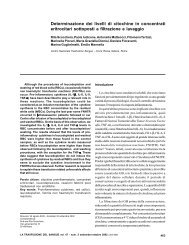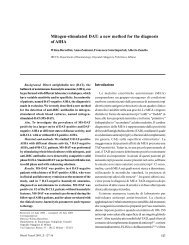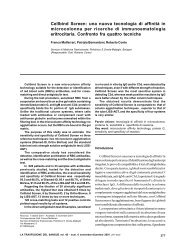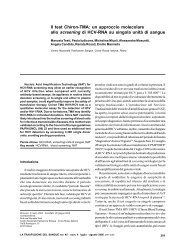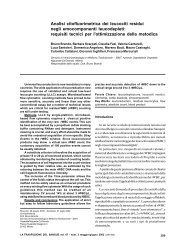Mathematics and transfusion medicine - Blood Transfusion
Mathematics and transfusion medicine - Blood Transfusion
Mathematics and transfusion medicine - Blood Transfusion
You also want an ePaper? Increase the reach of your titles
YUMPU automatically turns print PDFs into web optimized ePapers that Google loves.
Reverberi R , Reverberi LAnalogously, when blood is first transfused <strong>and</strong> thenwithdrawn:⎛= ⎜1 −⎝sk(V +⎞⎟s)⎠Residual fraction , (2)In Appendix B, the reader will find instructions forprogramming a spreadsheet to calculate the residual fractionaccording to the cycle volume <strong>and</strong> the neonate's bloodvolume. Some exemplary data are shown in table I.As can be easily noted, the efficiency of the exchangeis greater when blood is first withdrawn. The difference isproportional to the volume exchanged at each cycle. Thecycle volume influences the efficiency of the exchange in apeculiar way: when blood is first withdrawn, efficiency isproportional to the cycle volume, whereas when blood isfirst transfused, efficiency is inversely proportional to thecycle volume. However, as the cycle volume rarely exceeds10% of the total blood volume, the differences are limitedto a few percentage points.Formulae (1) <strong>and</strong> (2) do not include references to thepatient's haematocrit, nor to the haematocrit of thetransfused blood: contrary to the above cited opinions,the residual fraction only depends on the terms representedin the two formulae.Absolute amount of neonatal red cellsHowever, we should be more interested in the absoluteamount of the residual neonatal red cells, rather than thefraction. In this case it is clear that, if the neonate is anaemic,during the exchange it is possible to fall under a minimumntarget level of neonatal red cells earlier.Incidentally, this was the probable meaning of Wiener'ssentence cited above.Figure 1 compares the cases of two hypotheticalneonates, with the same weight (blood volume) but initialhaematocrits of 25% <strong>and</strong> 50%. If our aim is to leave no morethan 9 mL of neonatal red cells (about 10% of the normalinitial volume), the target is met in the first case after 14cycles of exchange <strong>and</strong> in the second after 20 cycles.The neonate's venous haematocrit at the endof the procedureDuring the exchange <strong>transfusion</strong>, neonatal red cells areprogressively substituted by the transfused cells. Thevenous haematocrit after n cycles of exchange (H n)principally depends on the haematocrit of the transfusedblood (H D) <strong>and</strong>, moreover, the volume exchanged at eachcycle (s), the number of cycles (n), <strong>and</strong> the neonate's initialvenous haematocrit (H V), according to the following formula(see Appendix A):nns ⎞ ⎛ s ⎞HnH ⎜ ⎛ ⎞⎜⎛ = 1 − ⎟ ×⎟V + 1 −×kV⎜ 1 − ⎟⎝ ⎠kV⎝ ⎝ ⎠ ⎠(3)The above formula is appropriate when the exchangebegins withdrawal of blood. The analogous formula for theopposite case is given in Appendix A.Figure 2 shows the kinetics of the substitution of thetransfused blood for the neonatal red cells <strong>and</strong> the changesof the patient's venous haematocrit during the exchange<strong>transfusion</strong>.HDTable I -Fraction of neonatal red cells remaining after 1, 2, 5, 10, <strong>and</strong> 20 cycles during the exchange<strong>transfusion</strong>. It is assumed that the volume exchanged at each cycle is 10% of the total bloodvolume. Columns "Withdrawal first" <strong>and</strong> "<strong>Transfusion</strong> first" show the results when the exchangebegins with withdrawal or <strong>transfusion</strong>, respectively. For the sake of comparison, the column on thefar right shows the results of an isovolumetric continuous flow exchange. Its efficiency is intermediatebetween the other twoCycle Total exchanged volume Residual fraction (%) of the neonatal red cells(% of the blood volume) Intermittent flow Continuous flowWithdrawal first <strong>Transfusion</strong> first1 10 89.0 90.0 89.52 20 79.2 81.0 80.15 50 55.9 59.1 57.410 100 31.2 34.9 32.920 200 9.8 12.2 10.894<strong>Blood</strong> Transfus 2007; 5: 93-101 DOI 10.2450/2007.0018-07093-101_reverberi.p65 9405/07/2007, 11.24



